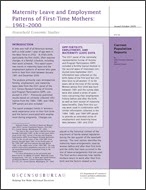Maternity Leave and Employment Patterns of First-Time Mothers: 1961-2000
Maternity Leave and Employment Patterns of First-Time Mothers: 1961-2000
Introduction
A little over half of all American women with a child under 1 year of age were in the labor force in 2002.1 A child’s birth, particularly the first child’s, often requires changes in a family’s schedule, including their work schedule. This report examines trends in maternity leave and the employment patterns of women who gave birth to their first child between January 1961 and December 2000.
The analysis primarily uses retrospective fertility, employment, and maternity leave data from the 2001 panel of the U.S. Census Bureau’s Survey of Income and Program Participation (SIPP), conducted in 2001.2 Previously published results based on similarly collected information from the 1984, 1985, and 1996 SIPP panels are also included.3
The report analyzes trends in women’s work experience prior to their first birth and the factors associated with employment during pregnancy. Changes are placed in the historical context of the enactment of family-related legislation during the last quarter of the twentieth century. The next section identifies the maternity leave arrangements used by women before and after their first birth and the shifts that have occurred in the mix of leave arrangements that are used. The final section examines how rapidly mothers return to work after their first birth and the factors related to the length of time they are absent from the labor force.
In addition to updating childbearing, employment, and maternity leave trends through the 1990s, the changes many new mothers experience in the number of hours worked, pay level, and job skill level after the first birth are detailed. These changes are examined in relation to whether a woman returned to the same employer she had during pregnancy or changed employers after the birth of the child.
_______________
1 Barbara Downs, Fertility of American Women: June 2002, Current Population Reports, P20-548, U.S. Census Bureau, Washington, DC, 2003.
2 The data in this report were collected from June through September 2001, in the second wave (interview) of the 2001 Survey of Income and Program Participation (SIPP); from August through November 1996, in the second wave of the 1996 SIPP; from January through April 1986, in the fourth wave of the 1985 SIPP; and from January through March 1986, in the eighth wave of the 1984 SIPP. The population represented (population universe) is the civilian noninstitutionalized population living in the United States.
3 For more information on the previously published report, see Martin O’Connell, “Maternity Leave Arrangements: 1961–85,” in Work and Family Patterns of American Women, Current Population Reports, P23-165, U.S. Census Bureau, Washington, DC, 1990.
Source and Accuracy
Below is the Source and Accuracy information from the Survey of Income and Program Participation:
Wave 2
Others in Series
Publication
Publication
Publication







